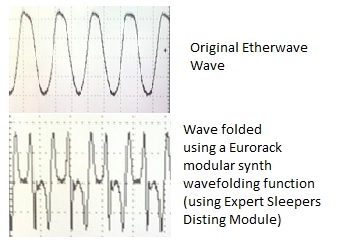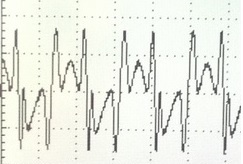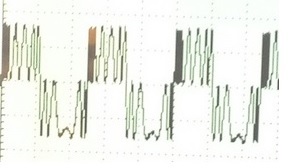The Moog Etherwave Plus theremin has the nice ability to change timbre through a waveform knob, basically changing from a more sinusoidal (though not totally sine) waveform to a wave pattern that has more clipped edges creating a more complex (i.e. buzzing) harmonic structure. In addition, there is a brightness knob that lets you have a little filter control that also lets you adjust timbre.
A large variety of subtle timbral changes can be made using these two knobs, however, I still find the Etherwave has a rather anemic sound in comparison with that of some of the older tube-based instruments I hear online, which to my ears have a more complex harmonic structure than the Etherwave. So while I am very happy with the Etherwave, with today's arsenal of DSP and effects processors, there is no reason to be limited with its "built in" range of timbres (or with any theremin for that matter).
So the problem at hand becomes, what are some ways of "tweaking" the harmonic complexity of the Etherwave in various ways to create a larger palette of more complex sounds without completely removing the theremin-like character of the sound? One technique I will write about later is adding tube saturation to the output through a DSP plugin, but a very interesting technique I've found that can add a lot of harmonic complexity to the theremin's sound (from subtle to extreme) is wavefolding.
A wavefolder is a form of wave shaping that basically folds the edges of a wave inwards on itself until the wave starts compressing completely and then the folding can continue from there if desired. Different Wavefolders can create different folding compressions and also some let you modulate the symmetry of the folding. This is best explained though a picture or two, however, the end result is that the folded wave takes on a much more complex harmonic structure.

Here's the same wave that is starting a second fold, now folding upwards:

And here's the wave that had been folded a number of times:

Each time the sound is folded, it becomes more complex. However, wavefolding is most effective when applied to simpler more sinusoidal waveforms with less harmonic content as the effect become more pronounced in this case as the harmonic content becomes more complex. This is exactly the kind of waveform produced by the theremin so it makes sense that the technique might be useful as a theremin effect, if not also useful to slightly alter a theremin's sound to give it a bit more "umpf".
I played in five "quick and dirty" examples to give you an idea of the possibilities. The first two are without wavefolding using the Etherwave Waveform knob at its least and most harmonically complex settings (full right/left, etc). After that three examples are played with successively more wavefolding. This example runs the output of the Etherwave through a Eurorack Expert Sleepers Disting module set to wavefolding mode. In fact, the theremin is a perfect input source and also CV controller (in the Etherwave Plus case) for modular synthesizers which today have a dizzying array of sound manipulation modules. For example, the Intellijel uFold2 is another module dedicated to wave folding and can also control the folding and symmetry through CV inputs as well (so the Etherwave CV outputs can be used to control wavefolding in real time through gestural control).
Etherwave Plus Wavefolding Example
I was pleasantly surprised at some of the sonic character that can be added to the theremin tone using wavefolding and to my ears some of the more subtle folding seems to add a bit of tone that I hear in some of the older tube-based theremins online. Maybe that's just me, but in any case, it's a very interesting technique that I plan on using in some compositions.


